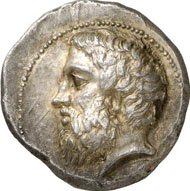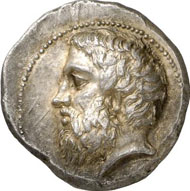A King Named Teutamados
Very little is known about the kingdom of Paionia. What we do know is that it lay in the northern part of Macedonia and that the Paionians eagerly pillaged the richer Macedonian states. At any rate, their coins depict Paionians on horseback hurling their spears at Macedonians lying on the ground (who are occasionally identifiable by their characteristic Macedonian shield).
The Paionians lived on the shores of the Axios (Vardar), right where the Erigon (Crna Reka) flows into it. This strategic position allowed them to preside over the attack route towards Macedonia in the North. Controlling the Paionians and their actions must have been a high priority for every ambitious Macedonian king; after all, they could encroach, unimpeded, at any time on Macedonian territory.
When Perdiccas III, predecessor of Philip II, was killed in the battle against the Illyrians, the Paionians – under the leadership of a man named Agis – used this opportunity to launch raids into Macedonia. Philip resolved the situation with bribery and Agis retreated, then died later that same year. Philip took this opportunity to pounce, and brought the Paionians under his control.
The unique coin of the virtually unknown King Teutamados brought in the considerable sum of 45,000 EUR instead of the estimated 15,000 in Gorny & Mosch, Giessener Münzhandlung Auction 175, No. 100.
From then on, the Paionian kings created a more or less autonomous buffer state independent from Macedonia. We know the Paionian client kings Lykkeios (356-335) and Patraos (335-315) primarily from their coinage. But whether Teutamados ruled prior to or after them, or if he was perhaps a counter-king of an independent tribal chapter, we still don’t know. For the time being, all we have is this tetradrachm from him, which was estimated at 15,000 EUR in Gorny & Mosch, Giessener Münzhandlung auction 175, No. 100 and sold for 45,000 EUR.
The front of it depicts the bearded head of a man, but of whom exactly? We’re not sure – perhaps of Zeus, or maybe of Teutamados himself. On the reverse, we find the usual Paionian male type, the horseman hurling a spear, whose face also bears portrait-like features. Is this intended to be a portrait of Teutamados himself? And will we ever find out? It’s a mysterious and enigmatic coin to say the least, but one that nonetheless offers an extraordinary testimony of the history of northern Macedonia.










